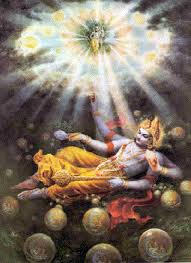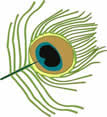Essence Of Maha Bhagavatha Purana |
|
 |
Varnashrama and Grihasti Dharma in PrahladaÆs Regime Suka Maha Muni informed King Parikshith as to how Prahlada ruled his Kingdom with justice, virtue and as per Scriptures. Narada who was a witness to the manner in which King Prahlada reigned was explained in detail to King Yudhishtara. Prahlada had unreserved devotion to the Supreme Lord, profound knowledge of Scriptures, unparralelled wisdom essential for a Ruler and most importantly a high sense of detachment devoid of material desires. Indeed these are the rarest of qualities that an ideal King could possess. |
Taking cue from the ideal governance followed by Prahlada, Narada defined ideal values of Varnashrama Dharma-the Four Class System- to ensure social values in a Society based on Spiritual Principles. Basically stated, the rudimentary observance of religious regime demands tolerance, truthfulness, austerity, simplicity, control of mind and senses, celibacy, charity, contentment, and non-violence. These qualities are applicable to one and all. Among ‘Dvijas’or twice born-intially by birth and subsequently after the Ceremony of wearing the Holy Thread – are the three categories viz. Brahmanas ( the Class of Religious Practice), the Kshatriyas ( the Class of Defenders of Dharma or Justice), the Vanijya Classs ( the Business and Trading Class) have larger responsibilities of socio-religious nature. Brahmanas should have vedic knowledge and practice and possess the qualities of austerity, spirituality, self control, physical cleanliness, purity of thought and action and daily ritualistic worship. Kshatriyas ought to protect, preserve and enforce regulations of the society and ensure law and order. Vysyas are expected to business interests of the Society, including agriculture and allied activities.The fourth class are meant for servicing the general needs of the Society. But if one shows symptoms of a specific class, the person be accepted to the duties of that category, irrespective of origin of birth. The Veda Base in this connection is: YasyaYallakshanam proktum / Pumso varnabhivyanjanam / yad anyaprapti drusyata / tat teniva vinirdisat – Yasya: of whom; yat:which; lakshanam: symptom; prokta : described ( as above); pumsah : of a person; varna abhivyanjakam : indicating the classification; yat:if; api:also; drusyeta : is seen; tat: that; tena : by that symptom; eva:certainly;vinurdiset: be accepted, [regardless of birth].( Bhagavata Purana:Canto 7, chapter 11, verse:35) King Yudhishtara requested Narada Maharshi to explain the life style of an ideal householder or ‘Grihasti Dharma’. He must earn his livelihood honestly without being concerned about the end result. Constant contacts with Saintly persons; detachment and contentment without excessive possesion; treating the poor, the helpless, innocent children and animals with compassion; practising daily worship and devotion to the Supreme Lord as also Demi-Gods; performing periodical oblations to Fire God, as per Shastras are among the duties. Brahmanas are to offer rituals to forefathers during the dark period of ‘Bhadra’ month and ceremonies during Mahalaya Amavasya during Asvina month. One should perform Shraddha ceremonies on Makara Sankranti day ( when Sun moves upward to north) and/ or Karkataka Sankranti ( when Sun travels to Southern direction) as also on Mesha Sankranti and Tula Sankranti. Ceremonies are also to be performed during Solar/Lunar eclipse days, Akhsaya Tritiya day, on the ninth lunar day of the bright moon phase in the month of Kartika and on the seventh lunar day of the bright phase of Moon in the month of Magha as also on the Janma Nakshatra days. Besides on the banks of Ganges and Yamuna, religious performances be done in temples or holy rivers, lakes or Sacred Places where Saintly persons live; for example, Pushkara lake, Kurukshetra,Gaya, Prayaga, Pulahasrama, Naimisaranya, banks of Phalgu river, Setubandha, Prabhasa, Dwaraka, Varanasi, Mathura, Pampa, Bindu Sarovara, Badarikasrama, Places where Narmada River flows, Chitrakuta and many other Places dotted all over in Bharata Desa or elsewhere where Lord Narayana is worshipped. In the pursuit of the four ‘end- principles’ of ‘Garhastya’viz. Dharma ( Virtue), Artha ( Wealth), Kama ( Desire) and Moksha ( Salvation), there are materialistic activities mixed with‘ the means’ of Adhyatmika ( Introspection), Adhidivika ( Devotion to the Lord) and Adhi Bhowtika (Physical Well Being).One is to be conscious of the ‘Means’ and the ‘Ends’. Equally important is to safeguard the negation of the Principles viz.Vidharma or (Irreligion), Paradharma ( Principles followed by others), Abhasa ( False similarity of religion), Upadharma ( parallel religion) and Chala Dharma ( misleading innocent victims). Thus ending the narration by Maharshi Narada to Yudhishtara regarding Varnashrama Dharma and Grihasti Dharma, Suka Maha Muni reverted back to his week-long recitation of Maha Bhagavata at the final stage of King Parikshith’s life. Earlier, he described the process of Creation and ‘Manvantaras’. As the first Manu -Svayambhu Manu- was retiring to the forests, the second and the third in the order, viz. Sarvochisa (Son of Lord Agni) and Uttama ( Son of King Priyavrata) suceeded. Tamasa Manu was the fourth in the Manu lineage.( At present, the contemporary world is under the Rule of the Seventh Manu,viz. Vaivasvata Manu). |
|
| Maha Bhagavatha Purana Home |  |
Next: Salvation of Gajendra the Elephant King |
Back to the News Page